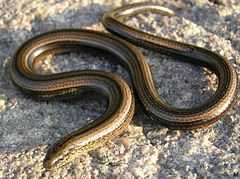Limbless vertebrates

Many vertebrates have evolved limbless or limb-reduced forms. Reptiles have on a number of occasions evolved into limbless forms - snakes, amphisbaenia, and legless lizards (limb loss in lizards has evolved independently several times, examples include the families Pygopodidae and Dibamidae and species of Isopachys, Anguis, and Ophisaurus). The same is true of amphibians - caecilians, Sirenidae (a clade of salamanders that are limbless except for atrophied front limbs), Amphiumidae (a clade of salamander with extremely atrophied limbs that appear non-functional) and at least two extinct groups (Aïstopoda and Lysorophia). Legless forms of reptiles and amphibians probably evolved so as to be able to move underground or in water more easily.
There are also a number of fish with elongated bodies that have no or reduced appendage-like fins, for example eels and swamp eels. While hagfish and lamprey also do not have appendage-like fins, they may not have lost them, but simply retained the form that vertebrates had before they evolved limbs.[citation needed]
There are no known limbless species of mammal or bird, although partial limb-loss and reduction has occurred in several groups, including whales and dolphins, sirenians, kiwis, and the extinct moa and elephant birds.
See also
- Terrestrial locomotion in animals
- Undulatory locomotion
- Snake evolution
- Limb development- Discussion of the genetic and developmental processes affecting limb growth.